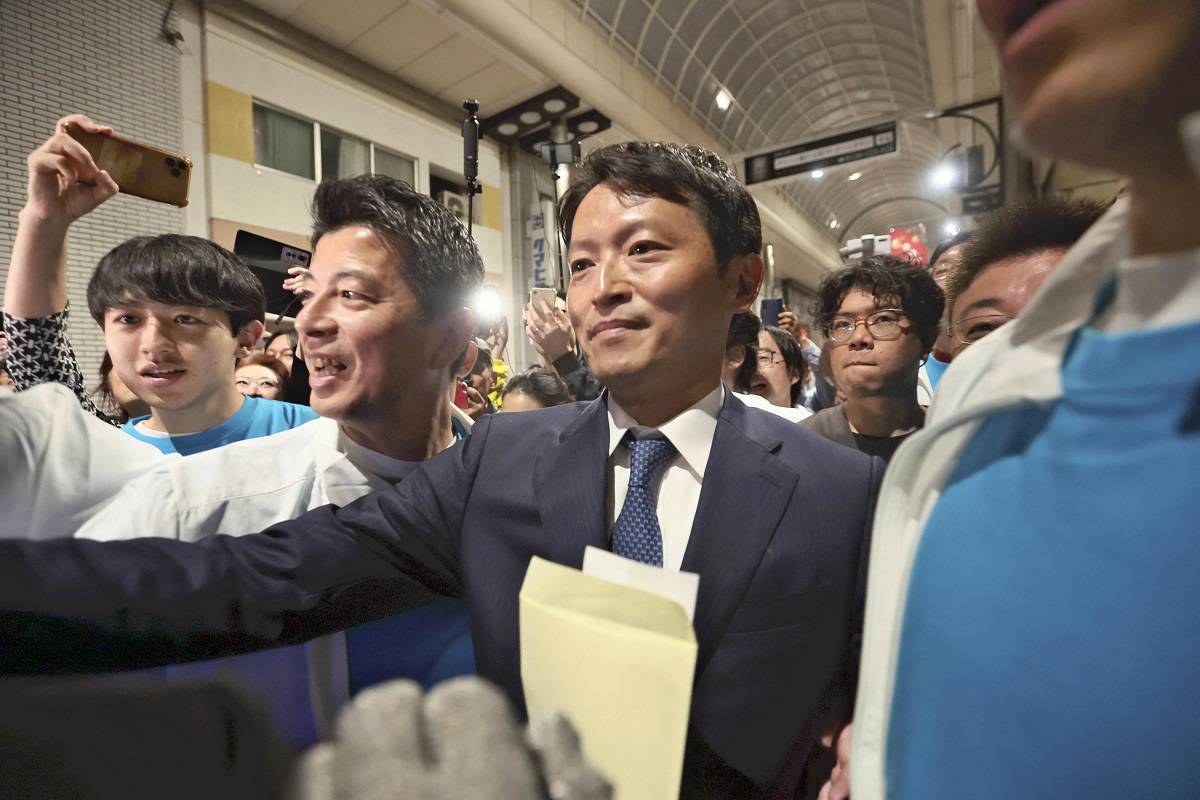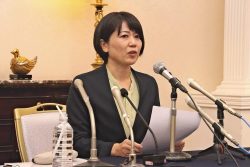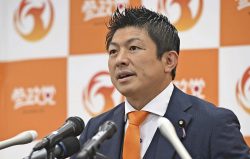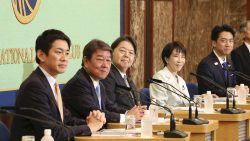Ex-Hyogo Governor Reelected Despite Power Abuse Scandal; Returns to Office Months After Unanimous No-Confidence Vote


Left: Motohiko Saito holds a flower bouquet on Sunday in Chuo Ward, Kobe, after being reelected as Hyogo governor.
Right: Motohiko Saito leaves his office after winning the Hyogo gubernatorial election on Sunday in Chuo Ward, Kobe.
16:06 JST, November 18, 2024
Former Hyogo Gov. Motohiko Saito was reelected in Sunday’s gubernatorial election, after losing the post in September over accusations of harassment.
Saito, 47, defeated six rookie candidates, including former Amagasaki Mayor Kazumi Inamura, 52. He called for continued reforms during his campaign, which successfully utilized social media.
Voter turnout was 55.65%, up from 41.1% in the previous election.
This is the second re-election of a governor who was voted out of office, after former Nagano Gov. Yasuo Tanaka in 2002.
The Hyogo prefectural assembly formed an investigative committee to examine the allegations and unanimously passed a no-confidence motion against Saito on Sept. 19 on the grounds that “the prefectural administration is at a standstill and in chaos.”
Saito automatically lost his position on Sept. 30, and a reelection was called. The campaign focused on the reconstruction of the prefectural administration, which was thrown into turmoil by the scandal, the qualifications to be governor, and an evaluation of Saito’s three years in office.
Saito ran without the support of any political party. He proposed measures to prevent a recurrence of the problem, such as establishing harassment prevention training for the governor and their staff. He also pledged to continue pursuing his policies, such as free tuition at prefectural universities.
Saito came under fire after a former director of the Nishi-Harima regional affairs bureau — who died in July — distributed an anonymous letter to media outlets in March accusing Saito of abusing his power. Instead of handling the situation as a case of whistleblowing, the prefecture identified the director, removed him from his position as director, and suspended him for three months from May.
Social media battle
During the campaign, Saito made full use of social media and even hit back against the prefectural assembly. Ultimately he confounded the belief that he was unlikely to be reelected.
Appearing in front of his office in Chuo Ward, Kobe, at 9:40 p.m. on Sunday, Saito was greeted by supporters calling out his name.
“I’m sorry for causing concern to many people in the prefecture,” Saito said. “I will accept the criticism and move forward with the administration with the support of all Hyogo Prefecture.”
In the previous gubernatorial election in 2021, when Saito was first elected, he was supported by the Liberal Democratic Party and the Japan Innovation Party. This time, however, he could not expect official support from political parties.
Saito’s camp therefore engaged in a “cyberspace battle,” making full use of social media and video-sharing websites. They drew on the example of Shinji Ishimaru, the former mayor of Akitakata, Hiroshima Prefecture, who deftly used cyberspace to finish second in the Tokyo gubernatorial election in July.
About 400 volunteers filmed and edited footage of Saito making speeches and interacting with supporters, and posted the content on social media. As a result, Saito’s followers on X, formerly Twitter, increased from around 70,000 at the end of September to around 190,000 in about a month and a half. His website had collected over 3,500 donations as of Thursday.
About halfway through the campaign, a growing number of comments defended him, including statements like “Saito shouldn’t be blamed.” He began criticizing the assembly that voted to dismiss him, saying, “Is the assembly really conducting politics for the people in the prefecture?”
Saito also posted such comments as “I didn’t mean to abuse my power” and “I want you to check X and YouTube to see if the media reported the matter correctly.”
Toward the end of the campaign, Saito mounted a charge against Inamura and overtook her quickly.
"Politics" POPULAR ARTICLE
-

Japan to Support Central Asian Logistics Route That Bypasses Russia, Plan to Be Part of Upcoming Summit in Tokyo
-

Japan to Tighten Screening of Foreigners’ Residential Status by Providing Information of Nonpayment of Taxes
-

Takaichi Cabinet Approval Holds at 72% as Voters Back Aggressive Fiscal Stimulus, Child Benefits
-

Chinese, Russian Bombers Flew Unusual Path by Heading Toward Tokyo; Move Likely Meant to Intimidate Japan
-

Takaichi Meets Many World Leaders at G20 Debut in Johannesburg; Speaks with Heads of Countries Including Italy, U.K., Germany, India
JN ACCESS RANKING
-

Keidanren Chairman Yoshinobu Tsutsui Visits Kashiwazaki-Kariwa Nuclear Power Plant; Inspects New Emergency Safety System
-

Imports of Rare Earths from China Facing Delays, May Be Caused by Deterioration of Japan-China Relations
-

University of Tokyo Professor Discusses Japanese Economic Security in Interview Ahead of Forum
-

Japan Pulls out of Vietnam Nuclear Project, Complicating Hanoi’s Power Plans
-

Govt Aims to Expand NISA Program Lineup, Abolish Age Restriction
























